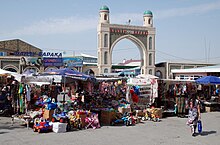Konibodom (Tajik: Конибодом, Persian: کان بادام; Russian: Канибадам) is in the southwestern part of the Ferghana Valley of Tajikistan. It is one of the most ancient settlements of Central Asia.
Understand
[edit]
In 2022, it was home to 54,400 people. Tajik, Uzbek and Russian are spoken in the city.
The business center of the city is the market on Lenin Street, with a city park and a few garden restaurants nearby. A brick minaret from the beginning of the 20th century stands in the park. There are one or two simple hotels on the main street, a theater used as a cinema and a teacher training facility.
The river Isfara flows through the valley in which the city stands.
The Big Fergana Canal runs along the southern outskirts of the city.
Get in
[edit]A376 road leading from Khujand to the Uzbek border bypasses the southern outskirts of the city and makes a loop before heading north as Aini Street (ulitza Aini), parallel to Lenin Street, past the city center to the east.
The stop for minibuses (marshrutkas), which go to the surrounding towns and villages, is on the ring road about 2 km south of the city center along Lenin Street.
Get around
[edit]Larger residential and commercial buildings line the central northwest-southeast Lenin Street. The
See
[edit]- Two madrasas have been preserved:
- Mir-Rajab-Dodkho (from the 16th century) has largely survived in its structural condition. It is north of the market and serves as a local history museum.
- Oim (from the 17th century) is found in a rural residential area about 4 km north of the center on Saifuloew Street, which branches off from Aini Street. The madrasa is one of the few Islamic schools in Central Asia founded by a woman. It contains separate areas for girls and boys with a number of individual rooms. In the Soviet era, the madrasa served as a prison from 1941, later as a farm camp and as a re-education center for boys. In 1996 the buildings were completely restored. The courtyard contains a landscaped garden. However, the facility is not used and is usually closed.
- Manor Khodjai Rushnoi (19th century),
- Langari-Bobo mausoleum
- 1 Mirrajab Dodkhoh Museum, Mir-Rajab-Dodkho. M-Th 08:00-12:00, 13:00-17:00; Sa Su 09:00-12:00, 13:00-16:00. The museum has more than 6,000 items, including collections of coins and manuscripts, arts and crafts, items of the traditional culture of the Tajiks of Northern Tajikistan. Paid entrance.
Do
[edit]Buy
[edit]Eat
[edit]Drink
[edit]Sleep
[edit]- 1 Gostinitsa Dushanbe, ul. Anyi, 543G / ул.Айни, 543Г.
Connect
[edit]Stay safe
[edit]Cotton cultivation, which was intensive in monocultures during the Soviet period, led to environmental pollution with pesticides. Between 1973 and 1999, large quantities of obsolete and now banned pesticides were dumped without protection at a landfill 5 km (3.1 mi) south of the Konibodom urban area. The unguarded and unfenced pesticide storage facility near the landfill, which contains around 4,000 tons of DDT, lindane and other toxins, poses a potential environmental hazard because it is located a few kilometers from Syr Darya and the Ferghana Canal. If the wind direction is unfavorable, toxic dust can reach the city.


